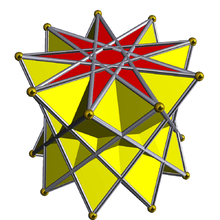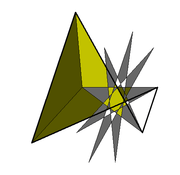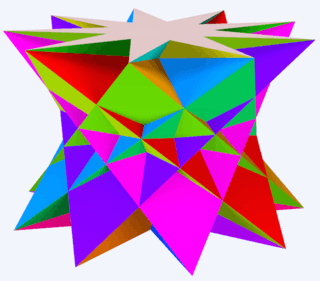Enneagrammic antiprism
| {9/2} enneagrammic antiprism | |
|---|---|
 | |
| Type | Uniform polyhedron |
| Faces |
2 {9/2} 18 {3} |
| Edges | 36 |
| Vertices | 18 |
| Vertex configuration | 9/2.3.3.3 |
| Wythoff symbol | |2 2 9/2 |
| Schläfli symbol | sr{2,9/2} |
| Coxeter diagram |
|
| Symmetry group | D9h, [2,9],(*299), order 36 |
| Dual polyhedron | Enneagrammic deltohedron |
| Properties | nonconvex |
| Vertex figure | |
 | |
In geometry, anenneagrammic antiprism is a star antiprism constructed by enneagrammic bases. There are two forms, built on the two enneagrams {9/2} and {9/4}, and one crossed form {9/5}.
A nonuniform 9/7 cross-antiprism can be constructed without equal edge-lengths.
A 9/3 ratio is reducible and so represents a compound polyhedron of 3 triangular antiprisms with 120 degree rotations between them.
9/2
The first solution is a 9/2 antiprism.
9/4
| {9/4} enneagrammic antiprism | |
|---|---|
 | |
| Type | Uniform polyhedron |
| Faces |
2 {9/4} 16 {3} |
| Edges | 36 |
| Vertices | 18 |
| Vertex configuration | 9/4.3.3.3 |
| Wythoff symbol | |2 2 9/4 |
| Schläfli symbol | sr{2,9/4} |
| Coxeter diagram |
|
| Symmetry group | D9h, [2,9],(*299), order 36 |
| Dual polyhedron | Enneagrammic deltohedron |
| Properties | nonconvex |
| Vertex figure | |
 | |

9/4-antiprism
9/5
| {9/5} enneagrammic crossed-antiprism | |
|---|---|
 | |
| Type | Uniform polyhedron |
| Faces |
2 {9/5} 18 {3} |
| Edges | 36 |
| Vertices | 18 |
| Vertex configuration | 9/5.3.3.3 |
| Wythoff symbol | |2 2 9/5 |
| Schläfli symbol |
s{2,18/5} sr{2,9/5} |
| Coxeter diagram |
|
| Symmetry group | D9d, [2+,18], (2*9), order 36 |
| Dual polyhedron | Enneagrammic concave deltohedron |
| Properties | nonconvex |
| Vertex figure | |
 | |

9/5-antiprism
See also
External links
| Wikimedia Commons has media related to Antiprisms. |
- Weisstein, Eric Wolfgang. "Antiprism". MathWorld.
- Olshevsky, George. "Antiprism". Glossary for Hyperspace. Archived from the original on 4 February 2007.
- Paper models of prisms and antiprisms
This article is issued from
Wikipedia.
The text is licensed under Creative Commons - Attribution - Sharealike.
Additional terms may apply for the media files.